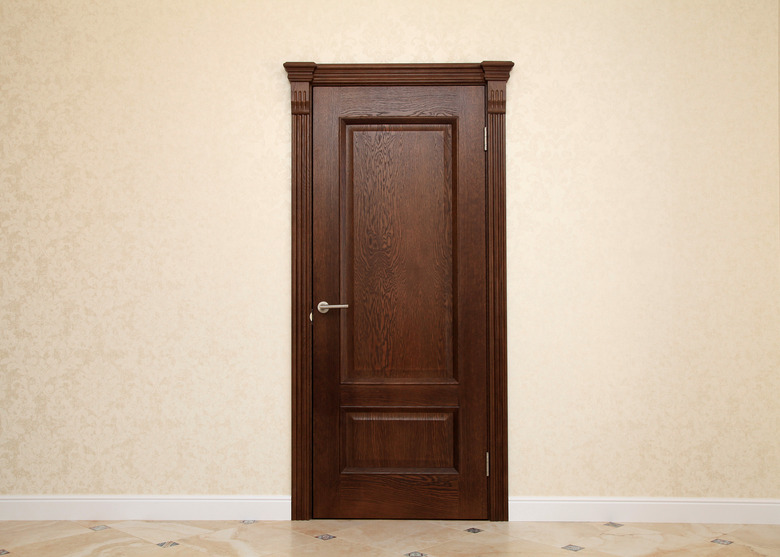What Is A Solid Core Door?
Solid core doors are solid from front to back. Made from wood byproducts, solid core doors are dense, heavy and withstand more punishment than hollow core interior doors. The typical solid core door is a mixture of wood particles glued together with heat, resins and hydraulic pressure to produce a uniform, consistent product. The most common solid core door is 1 3/8 inch for interior doors, and 1 3/4 inch for entryway doors.
Solid to the Core
The solid wood core, usually referred to as chipboard or particleboard, typically is surrounded by a perimeter of fir lumber to protect the edge and make the door appear as if was solid wood. Covered with a thin layer of veneer, a solid core door is visibly indistinguishable from a hollow core door. However, if the doorknob is removed, the particleboard core is visible inside the hole for the doorknob.
Hollow Versus Solid
Hollow core doors, used the majority of the time in the interior of most homes, are not actually hollow. Hollow core doors have a wooden framework, typically 1 1/8 inches in thickness with a honeycomb or grid-like core consisting of cardboard, foam or a combination of both. The frame and core support a veneer face adhered to the surface on both sides. Because veneer won't support hardware, solid wood blocking for doorknob installation is placed inside the frame.
Solid Wood Doors
Don't confuse solid core doors with solid wood doors. Solid wood doors are made with lumber. Assembled in pieces, they provide the familiar stile-and-rail construction standardized in home construction for many years. Solid wood doors are more exclusive and more expensive than solid core doors. Hollow core doors are the cheapest of all the doors – and one reason the majority of bedroom and bath doors are hollow core.
Hollow Core Interior Doors
Hollow core doors are noticeably lighter than solid core doors and are easier to handle and install. Solid core doors provide more security than hollow core doors. Hollow core doors are more likely to warp than solid core doors. Hollow core doors can be smashed or punctured with a solid kick. Solid core doors resist a significant beating with tools and absorb a tremendous amount of force before yielding – and it's often enough to turn back unlawful entry. Solid core doors are used more often as an exterior entry door for this reason, not to mention superior weather resistance when properly maintained with sealant or paint.
Shut the Door
Hollow core doors shut with a light click. Solid core doors, carrying extra weight, close with an authoritative thump. If slammed, the weight of the door causes a vibration when the door hits the jambs. The difference in weight requires a bit more force to get them moving in either direction. Hinges are another indicator of a solid core door; they're typically heavier and larger than hollow core door hinges.
Reduce Noise Pollution
Solid core doors provide better heat insulate than hollow core doors. If noise reduction or privacy is an issue, solid core doors insulate against sound penetration better than hollow core doors.
Consider the Veneer
The majority of solid core doors have a slick veneer face. The veneer may be purchased in a variety of hardwood such as birch or oak – two of the most common – or ordered in any species commonly used on other doors. Solid core doors can be routed to imitate a raised-panel door. In this instance, the particleboard core is exposed when routed and enamel paint is used en lieu of stain and lacquer, giving the door an appearance similar to a traditional hand-built, solid wood, stile-and-rail door.
Resistance to Heat
The standard solid core door, although not fireproof, provides better protection against fire than hollow core doors. Fireproof ratings can be boosted by adding different materials to the core. If fireproofing is important, look for added fire-resistant ratings at higher cost.
